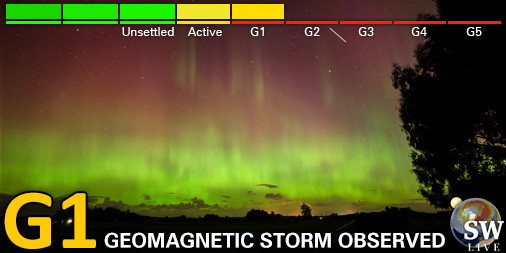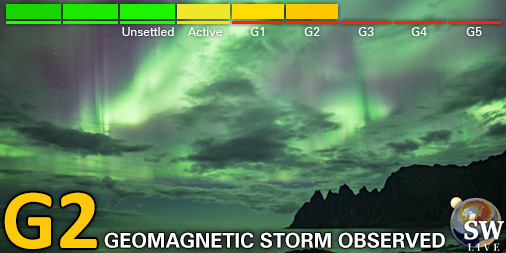Viewing archive of Tuesday, 20 October 2020
Daily bulletin on solar and geomagnetic activity from the SIDC
Issued: 2020 Oct 20 1249 UTC
SIDC Forecast
Solar flares
Quiet conditions (<50% probability of C-class flares)
Geomagnetism
Quiet (A<20 and K<4)
Solar protons
Quiet
| 10cm flux | Ap | |
|---|---|---|
| 20 Oct 2020 | 075 | 005 |
| 21 Oct 2020 | 075 | 009 |
| 22 Oct 2020 | 074 | 010 |
Bulletin
Solar flaring activity is low. Catania group 45 (NOAA AR 2776 - beta classification – disk centre) was the source of A-class flares in the last 24 hours. NOAA AR 2777 was the source of one A-class flares in the last 24 hours before it rotated off the visble disk. NOAA AR 2776 could be the source more low A and possibly B-class flares in the coming hours.
On Oct 19th an A8.3-class flare on NOAA AR 2776 was followed by a dimming visible in AIA 193 about 12:00UT. Due to its location any possible eruptions were hard to identify.
The greater than 10 MeV proton flux was at background levels over the past 24 hours. It is expected to stay at background levels for the next 24 hours. The greater than 2 MeV electron flux was at nominal to moderate levels over the past 24 hours, reaching a peak of 772 pfu at Oct 19th 18:45UT. It is expected to remain at those levels over the next 24 hours.
The speed of the solar wind varied between 345 and 450 km/s (DSCOVR). The polarity of the Interplanetary Magnetic Field (IMF) was predominantly away from the Sun (phi angle in the postive sector). Bz fluctuated between -5 and +9 nT. The magnitude of the magnetic field varied between 1 and 10 nT. The in situ observations showed the arrival of the shock wave on Oct 19th at 13:45UT. The magnetic field magnitude, increased from 5 to 10 nT, with a simultaneous increase at the solar wind speed, density and the temperature. The solar origin of the observed shock is unclear. It could be associated with a narrow Coronal Mass Ejection seen in STEREO A COR2 RD on Oct 14th 01:39UT on the Western limb, which was a narrow event but the confidence level is not high. A not prominent extension of the Northern Coronal Hole (CH) is about to cross Central Meridian (CM).
The geomagnetic conditions were quiet to unsettled due to the aforementioned shock. The values registered for the past 24 hours were 0-3 for K Dourbes and 1-3 for NOAA Kp. Quiet to unsettled conditions are expected for the next 24 hours as we await the HSS from the negative southern CH that crossed CM on Oct 17th.
Today's estimated international sunspot number (ISN): 012, based on 10 stations.Solar indices for 19 Oct 2020
| Wolf number Catania | 018 |
| 10cm solar flux | 075 |
| AK Chambon La Forêt | 014 |
| AK Wingst | 008 |
| Estimated Ap | 006 |
| Estimated international sunspot number | 015 - Based on 28 stations |
Noticeable events summary
| Day | Begin | Max | End | Loc | Strength | OP | 10cm | Catania/NOAA | Radio burst types | |
|---|---|---|---|---|---|---|---|---|---|---|
| None | ||||||||||
Provided by the Solar Influences Data analysis Center© - SIDC - Processed by SpaceWeatherLive
All times in UTC
Current data suggests there is a moderate possibility for aurora to appear at the following high latitude regions in the near future
Gillam, MB, Yellowknife, NTCurrent data suggests there is a slight possibility for aurora to appear at the following high latitude regions in the near future
Iqaluit, NU, Saskatoon, SKNuuk
Latest news
Latest forum messages
Support SpaceWeatherLive.com!
A lot of people come to SpaceWeatherLive to follow the Sun's activity or if there is aurora to be seen, but with more traffic comes higher server costs. Consider a donation if you enjoy SpaceWeatherLive so we can keep the website online!

Latest alerts
04:15 UTC - Geomagnetic activity
Minor G1 geomagnetic storm (Kp5) Threshold Reached: 04:05 UTC
03:15 UTC - Geomagnetic activity
Moderate G2 geomagnetic storm (Kp6) Threshold Reached: 02:59 UTC
01:00 UTC - Geomagnetic activity
Minor G1 geomagnetic storm (Kp5) Threshold Reached: 00:51 UTC
Friday, 4 April 2025
23:30 UTC - Geomagnetic activity
Minor G1 geomagnetic storm (Kp5) Threshold Reached: 23:17 UTC
21:03 UTC - Hemispheric Power Index
The OVATION model predicts the Hemispheric Power Index to reach 75GW at 21:49 UTC
Space weather facts
| Last X-flare | 2025/03/28 | X1.1 |
| Last M-flare | 2025/04/01 | M2.5 |
| Last geomagnetic storm | 2025/04/04 | Kp5+ (G1) |
| Spotless days | |
|---|---|
| Last spotless day | 2022/06/08 |
| Monthly mean Sunspot Number | |
|---|---|
| March 2025 | 134.2 -20.4 |
| April 2025 | 148 +13.8 |
| Last 30 days | 130.9 -15.2 |






